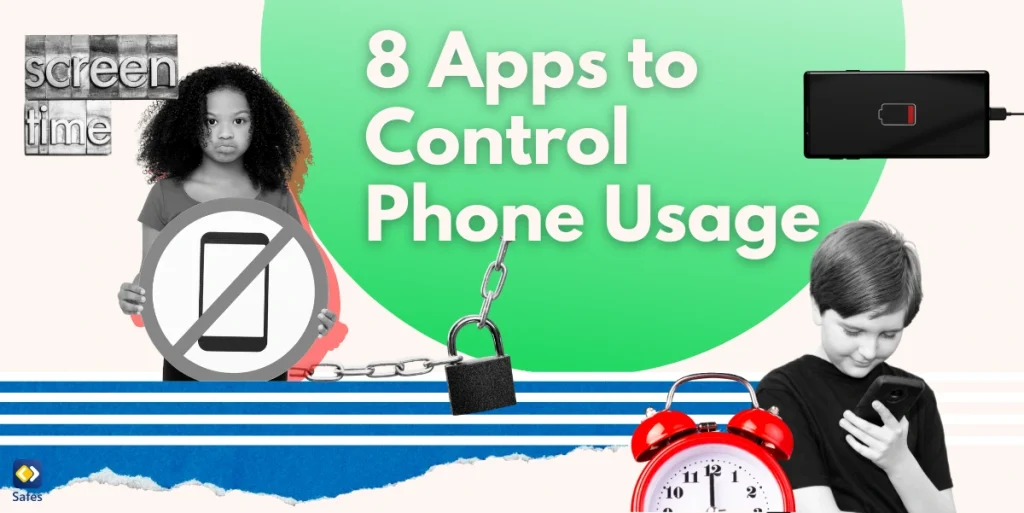I remember when my 10-year-old boy was watching his favorite TV show one night. It was a school night and way past his bedtime. I asked him several times to turn off the TV and go to sleep. But he just kept ignoring me. At last, I snatched the remote from him and that’s when I heard him say: “Shut up, go away!”. I was shocked, offended, and angry. I couldn’t believe that my innocent baby boy had acted so rudely, and even worse, toward me, his mother. I didn’t know what to do or say, I just froze there for a moment, staring blankly into nothingness. Then, I left the room and he kept on watching TV…
Download and Start Your Free Trial of the Safes Parental Control App
Respect is an important part of any successful relationship, and it’s particularly important to foster an atmosphere of respect among adolescents. Unfortunately, as all parents know, teens can be disrespectful and it can be difficult to handle. In this blog post, we’ll explain why teaching respect to kids is important. Plus, we’ll share some tips on how to handle disrespect in adolescents and how to foster positive relationships with them.
Why Dealing With Disrespect in Kids Is Important
Dealing with disrespectful behavior is an important issue for parents because it’s a key part of setting a positive example for their children. Teaching children to be respectful and to treat others with respect is a fundamental part of raising a successful, well-adjusted child. When children are disrespectful, it can have a negative effect on their relationships with their peers and adults. Disrespectful behavior can also lead to more serious issues such as bullying or other forms of aggression. Furthermore, disrespectful behavior can lead to feelings of guilt and shame for parents, as it’s ultimately their responsibility to teach their children respect. Here are 10 warning signs that you might be a bad mother.
Why Would Young People Behave Disrespectfully?
The first step toward dealing with disrespect in youth is to realize its underlying causes. As parents, you should be able to uncover why your child’s been acting rudely and take action accordingly. Here are some of the most probable causes:
Poor Parental Role Modeling
A research article published in 2019 states that human behavior is formed by social learning. Social learning refers to acquiring one’s behavioral traits from other people. This happens through watching them and imitating their behavior.
The same goes for children. Parents are the first people a child sees and has contact with. When parents are disrespectful to each other or their children, it can set the stage for their children to be disrespectful to them.
Attention Seeking
Some teenagers will be disrespectful in order to gain attention from peers or adults. Read our blog How Does Social Media Affect Teenagers’ Self-Esteem?
Lack of Self-Control
Teens may be disrespectful when they’re overwhelmed by their emotions and are unable to regulate their behavior.
Unclear Expectations
When there are no clear expectations set for how to behave, it can lead to disrespectful behavior.
Unresolved Conflict
If teenagers have unresolved conflicts with their parents or other adults, it can lead to disrespectful behavior.
Read our blog for a more comprehensive insight into the causes of disrespectful behavior in children.
What Counts as Disrespectful Behavior?
Disrespectful behavior in teenagers is any behavior that is rude or disrespectful towards others, including adults. Disrespectful behavior can range from minor issues such as talking back, making rude comments, or eye-rolling, to more serious issues such as ignoring requests or instructions, refusing to follow rules, or engaging in other forms of aggression such as name-calling or bullying. Such behavior can often have a negative impact on relationships, both with peers and adults, and can lead to feelings of guilt and shame for both the teen and their parents. It’s therefore very important for parents to teach their children to be respectful and to treat others with respect.
How to Handle a Disrespectful Teenager
Nobody wants to deal with a rude child. Sometimes their behavior pushes your buttons so much that it makes you want to scream from the top of your lungs and say some of the worst, most obscene words you know. However, the most important thing that you should do is to remain calm and not lose your cool. Acting violently toward a disrespectful child not only doesn’t teach them manners, but it also has an adverse effect on their behavior. According to a study published in the American Psychological Association, parents’ use of violence as a disciplinary measure such as corporal punishment increases the risk of developing violent behaviors in kids. Here are 5 approaches to discipline a child without hitting. You should follow these six effective tips on how to deal with an angry disrespectful child instead:
Set Clear Boundaries
Setting clear boundaries and expectations for how to behave and what’s acceptable is an important part of teaching children to be respectful. It’s important to be consistent in enforcing these boundaries and expectations so children understand that their behavior is unacceptable. Pick an appropriate time to discuss the rules with your child. Use a serious tone and put joking aside. However, try not to sound threatening.

Model Respectful Behavior
Children learn by example, so it’s important for parents to model respectful behavior themselves. This means being aware of your own behavior and language and making sure that you’re showing respect to your child and others.
Picture this scenario: You’re back from work, angry with one of your coworkers. You’re explaining the reason for your anger to your partner, while your child is in the room. You say:
“I’m so mad I want to scream. Stupid Tracy ruined my life! She’s the reason my request for promotion was denied. That b*** has been badmouthing me at the office all along. Makes me want to mess up that snake’s car and leave a threatening note on her windshield.”
What’s wrong with this attitude? Using inappropriate words, threat of resorting to violence when you’re angry, name-calling, etc. Instead, try to express your anger in a way that looks more like this:
“I’m extremely mad right now. I just realized that my coworker Tracy has been badmouthing me to my boss and that’s why I didn’t get the promotion I asked for. This was a real stab in the back and makes me feel awful. I should probably look for ways to defend myself in front of my boss.”
This is a healthier approach that teaches your child to look for solutions when an issue comes up instead of just expressing their anger in destructive ways.
Encourage Open Communication
Creating an atmosphere of open communication between parents and children is essential in order to foster respectful behavior. It’s important to actively listen to your child and be available to talk with them so they feel comfortable expressing their feelings and opinions. Read our blog to learn how to do that: Help Teens Open Up: How to Get a Teenager to Talk About Their Feelings.
Establish Consequences
Establishing and enforcing appropriate consequences for disrespectful behavior can help to show your child that their behavior is unacceptable. Make sure you’re firm in enforcing these consequences, and that the consequences are proportional to the offense.
Safes, a parental control app, can help parents with disrespectful teenagers by providing them with more insight into their child’s behavior. Safes allows parents to monitor their child’s activities on their devices, such as which apps they’re using, the websites they’re visiting, and who they’re communicating with. This can help parents to identify any potential issues that may be contributing to their child’s disrespectful behavior, such as cyberbullying or exposure to inappropriate content. Safes also allow parents to set limits and restrictions on their child’s devices, such as limiting screen time or blocking certain websites. This aids parents in protecting their kids from the internet’s ability to teach disrespectful behavior. On top of that, it doesn’t matter if you’re using an iOS, Android, or Windows device, as it can be installed on all devices.
Find the Root Cause
Identifying the underlying cause of disrespectful behavior can help to address the issue more effectively. This could involve talking to your child to find out what’s causing them to act out or exploring potential triggers such as stress or anxiety. If you feel that the issue is serious, don’t hesitate to consult a specialist.
Focus on Positive Reinforcement
Acknowledging and rewarding positive behaviors is an important part of teaching respect. It’s important to reinforce the idea that respect is important and to make sure that your child knows that their good behavior is appreciated. The reward shouldn’t necessarily be very big, but it should be something they like, such as pizza or a night out with friends.
Conclusion
As parents, it’s our responsibility to teach our children to be respectful and to treat others with respect. This begins at home and starts with us. We can set clear boundaries and expectations, and model respectful behavior ourselves. We should also establish consequences for disrespectful behavior and work to identify the root cause of any issues. Additionally, we should focus on rewarding positive behavior and reinforcing the idea that respect is important. By taking these steps, we can learn how to handle disrespect and provide our children with a positive example that they can follow. It’s only through our own respect and understanding that we can ensure our children grow up to be respectful and successful adults.
Your Child’s Online Safety Starts Here
Every parent today needs a solution to manage screen time and keep their child safe online.
Without the right tools, digital risks and excessive screen time can impact children's well-being. Safes helps parents set healthy boundaries, monitor activity, and protect kids from online dangers—all with an easy-to-use app.
Take control of your child’s digital world. Learn more about Safes or download the app to start your free trial today!




